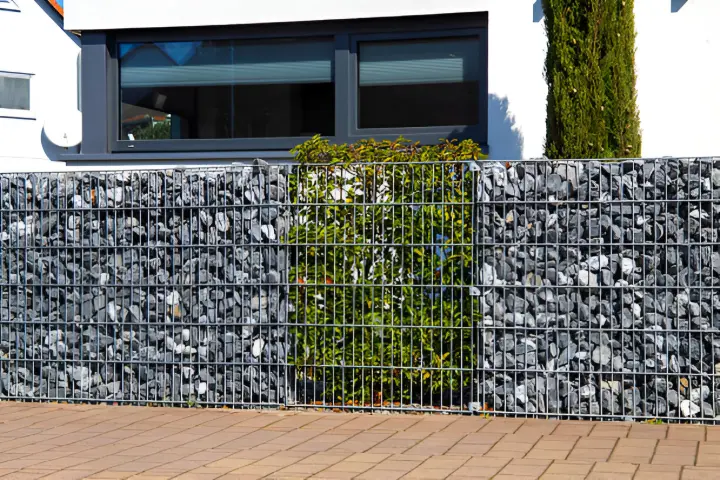In arid and harsh environments like the deserts of Saudi Arabia, designing resilient infrastructure isn’t just about aesthetics or tradition—it’s about functionality, climate adaptability, and long-term performance. When it comes to retaining walls or protective barriers, the two most commonly debated options are Gabion Walls and Concrete Walls.
Each has unique characteristics, but only one may truly meet the challenges posed by desert climates: high temperatures, sudden rainfall, sand erosion, and scarce water. Let’s explore a comparative view to help you make the right decision.
Why the Climate Matters in Wall Design
Before diving into materials, it’s essential to understand the environmental challenges specific to desert regions:
- Extreme heat causes materials to expand and contract, stressing rigid structures.
- Occasional flash floods from rare but heavy rainfalls lead to erosion.
- High salinity and dust can deteriorate surface coatings.
Limited water retention in sandy soil destabilizes traditional foundations.

What Are Concrete Walls?
Concrete walls are constructed using cement, aggregates, water, and steel reinforcement. They are known for:
- High compressive strength
- Long life spans (with proper maintenance)
- Smooth and consistent structural alignment
Concrete walls are typically used in urban settings, highways, or high-load-bearing applications where vertical space is a constraint.
Pros
- High structural integrity
- Smooth finish for architectural use
- Can be engineered to extreme load tolerances
Cons
- Requires deep foundations
- Susceptible to cracks in extreme temperatures
- Poor drainage unless designed with weep holes
- Time-consuming and expensive to construct
- Thermal expansion may cause structural stress
What Are Gabion Walls?
Gabion walls are flexible, rock-filled wire cages—either welded or hexagonal mesh—stacked and arranged to form gravity-retaining or erosion-control structures.
They are especially useful in environments prone to shifting soils, erosion, or hydraulic forces.
Pros
- Excellent drainage, reduces hydrostatic pressure
- Flexible, adjusts with minor ground movements
- Faster installation with minimal foundation work
- Cost-effective, especially for large-scale or remote projects
- Can use locally sourced rock for filling
- Can be greened over time (eco-friendly)
Cons
- Not ideal for very tall vertical walls without reinforcement
- Exposed wire may corrode without proper coating
A more rugged, less polished appearance than concrete
Key Comparison: Desert Climate Performance
| Feature | Gabion Walls | Concrete Walls |
|---|---|---|
| Heat Resistance | Excellent: Airflow through rocks reduces heat buildup | Moderate: Prone to cracking under temperature fluctuation |
| Drainage Capacity | High: Natural voids allow water flow | Low: Requires additional drainage pipes |
| Erosion Resistance | High: Especially for slopes and embankments | Low unless reinforced |
| Foundation Needs | Minimal: Works on sand or unstable soil | High: Requires deep, compact foundations |
| Eco-friendliness | Very High: Can integrate vegetation | Low: High carbon footprint during production |
| Installation Time | Fast: Simple assembly | Slow: Multiple curing stages required |
| Visual Appeal | Natural, rustic aesthetics | Sleek, modern appearance |
| Maintenance | Low (if coated properly) | Medium to high over long periods |
| Cost (Desert Projects) | Lower for large, spread-out projects | Higher due to material and labor costs |
Gabion Walls: Airflow through rocks reduces heat buildup
Concrete Walls: Prone to cracking under temperature fluctuation
Gabion Walls: Natural voids allow water flow
Concrete Walls: Requires additional drainage pipes
Gabion Walls: Especially for slopes and embankments
Concrete Walls: Low unless reinforced
Gabion Walls: Works on sand or unstable soil
Concrete Walls: Requires deep, compact foundations
Gabion Walls: Can integrate vegetation
Concrete Walls: High carbon footprint during production
Gabion Walls: Simple assembly
Concrete Walls: Multiple curing stages required
Gabion Walls: Natural, rustic aesthetics
Concrete Walls: Sleek, modern appearance
Gabion Walls: Low (if coated properly)
Concrete Walls: Medium to high over long periods
Gabion Walls: Lower for large, spread-out projects
Concrete Walls: Higher due to material and labor costs
Sustainability and Eco-concious space in KSA
Deserts aren’t always dry wastelands—many development projects now aim to introduce green zones, parks, and oases. Gabion walls can be easily incorporated into such eco-friendly designs:
- Soil and seeds can lodge in rock crevices, allowing natural vegetation over time
- The system supports wildlife integration and reduces heat islands
- Aesthetic blending with natural surroundings
Concrete walls, in contrast, tend to dominate visually and offer little to no environmental integration.
Conlusion
One often overlooked factor in desert construction is the unexpected intensity of flash floods. With poor water absorption in the soil, standing water builds pressure behind retaining walls. If not released, this hydrostatic pressure can cause structural failure. Gabion walls allow water to pass naturally through the rocks, eliminating the need for complex drainage systems an enormous plus for desert infrastructure. In the Kingdom of Saudi Arabia, infrastructure must endure the severe and fluctuating temperatures of the desert. Gabion walls have proven highly successful in wadi protection and rehabilitation, slope stabilization along highways, retaining structures in Neom and Vision 2030 green projects, and drainage channels in flood-prone areas like Jeddah.